February 2, 2007
Air Date: February 2, 2007
FULL SHOW
SEGMENTS
Gorilla of Sea Level Rise
View the page for this story
The Intergovernmental Panel on Climate Change released a new report on the state of scientific knowledge on climate change. But some say the scientists who wrote the report were overly conservative in their predictions, particularly those for sea level rise. NASA scientist James Hansen tells host Steve Curwood why melting ice sheets could lead to rising sea levels and global catastrophe. (06:45)
Accusations of Interference On Climate
View the page for this story
Congressman Henry Waxman tells host Steve Curwood that legislators need accurate science, unaltered by political motivation, so they can make informed decisions when making policy. The California Democrat held a hearing where scientists gave testimony about government suppression of information about climate change. (05:00)
Will Congress Act On Climate Change? / Jeff Young
View the page for this story
Legislators on Capitol Hill took the first, halting steps toward a plan to address global warming. Key members, including several presidential candidates, say they have moved beyond debate about whether global warming is a real problem. But that does not make the debate on a solution any easier. Living on Earth’s Washington correspondent Jeff Young reports. (05:00)
Deep Heat / Curt Nickisch
View the page for this story
A report by the Massachusetts Institute of Technology says the United States should invest money in tapping energy from deep in the ground. Curt Nickisch reports on the promise of a new geothermal technology process called heat mining. (05:00)
Limiting Federal Regulators
View the page for this story
Living on Earth's host Steve Curwood talks with Texas University, Austin Law Professor Tom McGarity about President Bush’s executive order that will increase White House control over agencies such as the Environmental Protection Agency and the Occupational Safety and Health Administration. Professor McGarity says the new directive will change federal agencies’ ability to protect the environment and human health. (05:30)
This Old (Green) House
View the page for this story
“This Old House” goes to Austin, Texas to renovate an old bungalow the eco-friendly way. The home restoration show’s master carpenter, Norm Abrams, and head builder, Bill Moore, tour the house with host Steve Curwood and talk about why green building makes environmental and economic sense. (06:30)
Emerging Science Note/Pills or Placebos? / Meghan Vigeant
View the page for this story
Meghan Vigeant reports on a device to detect counterfeit drugs. (01:30)
Life Lessons From Wildlife
View the page for this story
Author Tim Smith talks with Living on Earth’s Bruce Gellerman about Buck Wilder, the friendly woodsman who’s the star of his series of kid’s outdoor adventure books. Smith writes about the animal kingdom to teach moral lessons and foster a love for nature in his young readers. (08:00)
This week's EarthEar selection
listen /
download
Natural sound from Michigan's Upper Peninsula.
Show Credits and Funders
Show Transcript
HOST: Steve Curwood
GUESTS: Norm Abram, Dr. James Hansen, Tom McGarity, Bill Moore, Henry Waxman
REPORTERS: Curt Nickisch, Jeff Young
SCIENCE NOTE: Meghan Vigeant
CURWOOD: From Public Radio International - this is Living on Earth.
[THEME]
CURWOOD: I’m Steve Curwood. The latest international scientific report of climate change says the earth is warming, thanks to humans, but there is dissent over what that will mean when it comes to melting ice and the potential for catastrophic flooding.
HANSEN: I would have preferred an even clearer statement about the dangers of future sea level rise if the ice sheets begin to disintegrate. And I think that a business as usual scenario will guarantee future disintegration of West Antarctica and parts of Greenland
CURWOOD: Also, a call to tap the heat of the earth as a source of energy free from the perils of global warming gases.
TESTER: America is particularly well blessed with geothermal. This would be an enormous asset to our long-term energy security, and I think in a very sustainable fashion.
CURWOOD: That and more this week on Living on Earth. Stick around!
CURWOOD: From Public Radio International - this is Living on Earth.
[THEME]
CURWOOD: I’m Steve Curwood. The latest international scientific report of climate change says the earth is warming, thanks to humans, but there is dissent over what that will mean when it comes to melting ice and the potential for catastrophic flooding.
HANSEN: I would have preferred an even clearer statement about the dangers of future sea level rise if the ice sheets begin to disintegrate. And I think that a business as usual scenario will guarantee future disintegration of West Antarctica and parts of Greenland
CURWOOD: Also, a call to tap the heat of the earth as a source of energy free from the perils of global warming gases.
TESTER: America is particularly well blessed with geothermal. This would be an enormous asset to our long-term energy security, and I think in a very sustainable fashion.
CURWOOD: That and more this week on Living on Earth. Stick around!
Gorilla of Sea Level Rise
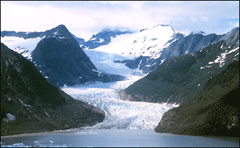
Glaciers like this in Greenland are melting and contributing to the rise in sea level. (Courtesy of the NOAA Photo Library)
CURWOOD: From the Jennifer and Ted Stanley Studios in Somerville, Massachusetts - this is Living on Earth. I’m Steve Curwood. The newest consensus statement of the thousands of scientists in the Intergovernmental Panel on Climate Change says there’s little doubt that the earth will be a much hotter place by the end of the century.
The pronouncement is the result of five years of collaborative work assessing what lies ahead for our warming planet. But some of the world’s leading climate experts say there is a glaring omission regarding another key impact of global warming, sea level rise.
The panel predicts a sea level rise of about a half a meter, or roughly 18 inches, over the next century. But NASA scientist Dr. James Hansen has just written an article in the Journal Science asserting, among other things, that this estimate may be far too low. Dr Hansen joins us now. Welcome to Living on Earth.
HANSEN: Glad to be here.
CURWOOD: And we should probably point out that you are expressing your own opinions here not those of NASA, correct?
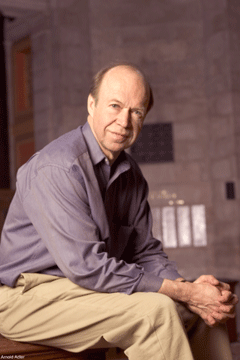
James E. Hansen (Courtesy of The Goddard Institute for Space Studies)
CURWOOD: So in your article in Science you looked at what past Intergovernmental Panel on Climate Change reports predicted. What did you find?
HANSEN: Well, we looked at carbon dioxide how the rate of growth of carbon dioxide, the change of global temperature, and the change of sea level. And contrary to what critics have often said, IPCC has not overstated or overestimated those changes. The changes of carbon dioxide have been very accurate. Temperatures actually increased somewhat faster than projections. And sea level has increased notably faster than the prior estimates by IPCC.
CURWOOD: So with that in mind how should we view predictions from this latest IPCC assessment? What did the report leave out or underplay from your view?
HANSEN: Well I think that there is a natural reticence which may derive from the scientific method which says you should be skeptical. You should check all sides of a story and before you make a very strong conclusion. The difficulty here is that I think we have very limited time to get on a different path with our energy use and greenhouse gas emissions or we’re going to end up with unstoppable problems in the future. And I would have preferred an even clearer statement about the dangers of future sea level rise if the ice sheets begin to disintegrate. And I think that a business as usual scenario will guarantee future disintegration of West Antarctica and parts of Greenland.
CURWOOD: So your concern about the chance of loss of large sheets of ice and the considerable impact that that could have on sea level rise is echoed by, um, Ohio State University scientist Lonnie Thompson and he says that those issues are gorillas in the room that the IPCC isn’t paying as much attention to as he thinks it ought to.
HANSEN: Well that’s a very good point because IPCC addresses a lot of things but there are a small number which deserve very great attention. And this, I think, is the number one item just because of the inertia of the system. If we get it started it will become very difficult to stop it, perhaps impossible to stop it.
CURWOOD: Well, how do scientists relay the risk there when there is frankly a lot of uncertainty about what might happen?
HANSEN: Well, you know we do have a lot of information available to us both from paleoclimate; the history of the earth and how ice sheets responded in the past and also the new data from satellites, and on surface measurements on the ice sheets which shows that there are processes beginning to happen there, exactly the processes that we’re afraid will accelerate. The last time a large ice sheet melted sea level went up at a rate of five meters per century. That’s one meter every 20 years. And that is a kind of sea level rise, a rate which the simple ice sheet models available now just cannot produce because they don’t have the physics in them to give you the rapid collapse that happens in a very nonlinear system.

Glaciers like this in Greenland are melting and contributing to the rise in sea level. (Courtesy of the NOAA Photo Library)
CURWOOD: Could you explain what you mean by a nonlinear event?
HANSEN: Well, it’s one in which the response begins slowly but you reach a certain point and suddenly things collapse. So you get a very rapid change. And you can imagine that in the case of large ice sheets. There are several processes that contribute to more rapid loss of ice. As you have melt on the surface of the ice sheet it descends through holes and crevasses to the surface and lubricates the base so that the ice sheet begins to move faster. There’s ice at the edge of the continent, both Greenland and especially West Antarctica, which holds back the ice streams but as the ocean warms and those ice shelves melt that’s like taking the cork out of a bottle and stuff can come out much more rapidly. And even as the ice sheet begins to decrease in size the surface lowers to a lower altitude where it’s warmer and so it melts faster. So you get these multiple positive feedbacks and then you get a sudden collapse and sea level goes up very rapidly. We’re going to guarantee that that happens eventually. If we get warming I would argue of more than 1 degree Celsius additional above that of year 2000.
CURWOOD: Now the present IPCC physical assessment has a center point of about 3 degrees Centigrade increase in temperature.
HANSEN: Yeah so that’s inconsistent with the numbers that they gave for sea level. Now IPCC could not estimate the ice sheet contribution because it is a nonlinear problem and they don’t know how to do it. Ah, but I think they should warn people more strongly about that danger because I think it’s the greatest danger that humanity faces in the global warming problem.
CURWOOD: Professor Hansen how do you see this report affecting policy? What do you expect to happen among policy makers now that this latest assessment is out?
HANSEN: Well, I think it will have a very positive effect. I think there’s already movement among policy makers and there’s a better understanding of the public. Things are moving in the right direction and I think this could give an added impetus to that. The thing that we need to guard against is ineffective incrementalism. What we need is strong actions not some weak actions that slow down the growth rate a bit. We’ve got to get on a path where emissions are actually decreasing.
CURWOOD: Dr. James Hansen is director of the NASA Goddard Institute for Space Studies. Thank you so much sir.
HANSEN: It’s great to be here.
Related links:
- Intergovernmental Panel on Climate Change
- NASA's Goddard Insitute for Space Studies
Accusations of Interference On Climate
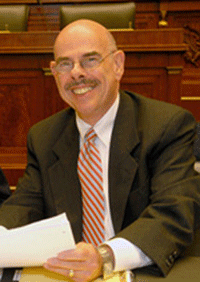
Representative Henry Waxman (Courtesy of The U.S. House of Representatives)
CURWOOD: Now you might remember that James Hansen made headlines last year when he spoke to this show, and others, about being pressured by the Bush Administration not to discuss his research on climate change. But it seems Dr. Hansen wasn’t alone. According to the Union of Concerned Scientists, fully a third of federal scientists responding to a survey perceived that they or their colleagues were pressured to play down terms like global warming in order to conform with the administration’s skeptical view of climate change.
Now the House Committee on Oversight is probing this alleged pattern of scientific censorship. California Democrat Henry Waxman chairs the committee and joins me now. Representative Waxman, welcome to Living on Earth.
WAXMAN: Hello, good to be with you.
CURWOOD: Congressman, what sort of evidence is being offered that scientists at public agencies were pressured to change results for political reasons?
WAXMAN: We heard pretty dramatic testimony, ah, from the union of concerned scientists who did a survey of government scientists who, ah, told in very detailed ways how they’ve had pressure put on them from people in the political side of this administration that didn’t want the science that they were working on to be presented. We also have had an opportunity at the staff level to review documents that the Council on Environmental Quality, and the staff reviewed documents showed a lot of what the climate change global warming scientists were trying to say were actually presented to the public and to the Congress in a filtered way. A former chairman of our committee, Republican congressman Tom Davis, and I wrote a very strong letter to the Council on Environmental Quality demanding all these documents. Our staff was able to go in and review them but there’s no reason we shouldn’t be able to receive them. These aren’t state secrets or classified information. And we need to get the documents and we need to get the science, from the scientists so that we can make informed decisions on policy.

Representative Henry Waxman (Courtesy of The U.S. House of Representatives)
CURWOOD: What connection, if any, do you see between the things that you’ve heard about and the Bush Administration’s reluctance to act on climate change?
WAXMAN: I think that what we’ve seen here is a political interference with the scientists. Some of the scientists told us that, um, that the changes that were made for example by the head of the Council on Environmental Quality who had , previous to that job been a lobbyist and lawyer for the petroleum institute, that he was making sure that when the scientific information was turned over to the Congress, it didn’t have some of the stark reality of what some of the scientists were reporting.
One of the views of which now there is a scientific consensus is that the global warming problem is due to man made sources. And rather than that clear statement being presented there was an edit that said that: it is unclear weather the causes for global climate change is due to man made problems. And that, of course, that is a complete reversal of what the scientists were trying to tell us.
CURWOOD: You say that the White House Council on Environmental Quality has been reluctant to turn over documents to you regarding this. When will you seek subpoenas to get those documents?
WAXMAN: We sent a very strong letter today indicating that after 6 months of trying these documents we’re not going to put up with any further delays. We do have the ability to subpoena but I hope that won’t be necessary.
CURWOOD: When will you have the leadership of these agencies in front of your committee to explain, or respond to these allegations?
WAXMAN: We’ll look at the issue further once we get the documents and make a decision as to further hearings.
CURWOOD: We heard in response to your hearings the criticism that, look, these stories, have been talked about before Congressman Waxman is just out to settle some old scores or get some partisan points against a Republican administration. How fair is that criticism?
WAXMAN: Well it’s certainly not partisan when it’s a bipartisan insistence that we get this information. And we are talking about the matters of dealing with the science on global warming. And every day we get new and new reports of reasons why we ought to be alarmed by the fact that we’re not doing anything to reduce our exposure to the pollutants that are warming our planet and causing damage at a faster rate than anybody ever envisioned.
CURWOOD: Henry Waxman is the California Democrat who now chairs the House committee on Government Oversight and Reform. Thank you so much sir.
WAXMAN: You’re welcome.
CURWOOD: We asked the White House Council on Environmental Quality for a response to the allegations of censorship. In an email reply a Council spokesperson wrote, "Claims that the Administration interfered with scientists are false. The nearly $2 billion worth of climate science we publish annually leads the world and speaks for itself."
Related links:
- Representative Henry Waxman's website
- Committee on Oversight and Government Reform
- Click Here for a Complete Report by the Union of Concerned Scientists
[MUSIC: Lloyd Cole “On Ice” from ‘Plastic Wood’ (One Little Indian - 2004)]
Coming up, it’s enough energy to warm and cool every home and business on the planet, it’s free and it’s right beneath our feet. Tapping the power of geothermal energy is just ahead on Living on Earth.
[MUSIC: Ethel “Be-In” from ‘Ethel ‘ (Cantaloupe Music – 2003)]
Will Congress Act On Climate Change?

Senator Barack Obama, D-IL, speaks during the ground breaking ceremony for the Martin Luther King, Jr. Memorial. (Courtesy of the U.S. House of Representatives AP Photo/Lawrence Jackson)
CURWOOD: It’s Living on Earth. I’m Steve Curwood. With growing awareness of climate change now on the public agenda, the debate is rapidly shifting on Capitol Hill.
Until recently the choices in Congress have mostly been between imposing modest caps on global warming gases or having no caps at all. Now, key members of Congress - including several presidential candidates - are suddenly proposing much stronger action to restrict emissions. But as Living on Earth’s Jeff Young reports from Washington, that doesn’t mean the debate is any less contentious or complex.
YOUNG: One senator called it open mic night. When environment committee chair Barbara Boxer asked for ideas on climate change a third of the senate showed up for a marathon session. The result was the first outlines of a global warming policy from five competing proposals and four presidential contenders.
OBAMA: We’ve moved from the question “Is it real?” to the question, “What can we do about it?"

Senator Barack Obama, D-IL, speaks during the ground breaking ceremony for the Martin Luther King, Jr. Memorial. (Courtesy of the U.S. House of Representatives AP Photo/Lawrence Jackson)
YOUNG: That’s Illinois Democrat Barack Obama, maybe you’ve heard the name lately.
Obama decided to join two of his potential rivals for the white house—Senators Hillary Clinton and John McCain—in the Climate Stewardship Act. It’s the first major proposal in the senate to seek a mandatory cap on carbon dioxide emissions and set up a system for trading emissions permits. Obama says it’s the best way to commercialize clean energy technology.
OBAMA: Once you put a value on carbon reductions you make winners out of innovators, it’s a framework that’s not only good for the environment it’s also good for business and that, I think, is the classic American way.
YOUNG: All the major proposals so far include some form of this mandatory cap and trade system. But that’s where the similarities end. Massachusetts Democrat John Kerry says the Climate Stewardship Act does not do enough to avoid major changes to the climate.
KERRY: There is this ominous notion of a tipping point, which we have to avoid, so the bottom line is, we really, the reason I mention all this, I know it’s accepted, I know the science is accepted, but the urgency is not accepted up here.

Senator John Kerry, D-MA, speaks at a recent holiday reception. (Courtesy of the U.S. House of Representatives)
SANDERS: Some people have said, well, we don’t want to change the American lifestyle. Well you know what, I do. And if our lifestyle is about driving cars that get 10 or 12 miles per gallon as we destroy our planet I say yeah, I think the American people are, in fact, ready to change that aspect of our lifestyle.
YOUNG: Others say those deep cuts in emissions from all sectors of the economy are too drastic. Delaware Democrat Tom Carper favors a go-slow approach.
CARPER: Imagine you’ve got a car going down the highway at 55 miles per hour, you put the car in reverse. I think there’s a smarter approach. Slow down the car, slow down the growth of CO2 emissions. Stop the car, stop the growth of CO2 emissions, put the car in reverse. That makes a whole lot more sense to me.

Senator Carper, D-DE, at the Delaware Military Academy’s Commemoration. (Courtesy of the U.S. House of Representatives)
Senate energy committee chair Jeff Bingaman offered an independent cost review of his economy-wide cap and trade proposal—it’s about one-tenth of one percent of the country’s economic output. But that’s not good enough for Missouri Republican Kit Bond.
BOND: Witnesses testifying said it would have little macro economic effect. Well I’m not from state of macroeconomics; I’m from the state of Missouri. And I need to know how these proposals will hurt Missourians.
YOUNG: Bond’s point is this: even if a cap and trade system has moderate average cost, the cost is not evenly distributed—some regions come out losers. Michigan Democrat Carl Levin warned against fuel efficiency standards that would punish an already beleaguered US auto industry. Coal states are also concerned. And it’s in that economic anxiety that Oklahoma Republican James Inhofe is mining for votes to stop the climate change bills. When Republicans controlled the senate Inhofe was chair of its environment committee and repeatedly called global warming a hoax. And while other senators speak passionately about a responsibility to future generations, Inhofe is unfazed by the judgment of history.
INHOFE: Oh I think when it’s over, I’ll probably be long gone by that time.
YOUNG: I mean if you can envision a history book sometime in the future with the
entry: Senator James Inhofe on climate change, what would it say?
INHOFE: I think it would say that he was right.
[LAUGHTER IN THE BACKGROUND]
YOUNG: If Inhofe finds just 40 other senators worried about coal, cars or other carbon intensive industry, any action on global warming could freeze in its tracks. For Living on Earth I’m Jeff Young in Washington.
Related links:
- "Energy Market and Economic Impacts of a Proposal to Reduce Greenhouse Gas Intensity with a Cap and Trade System"
- "Senator Sanders Introduces the Global Warming Pollution Reduction Act"
- "Six Major Energy Companies Endorse Senator Feinstein's Cap-and-Trade Legislation"
- "Senators Kerry and Snowe Introduce Landmark Bipartisan Climate Change Proposal"
- "Lieberman, McCain Reintroduce Climate Stewardship and Innovation Act"
- To see the U.S. Public Interest Research Group Fact Sheet on Global Warming Legislation please click here.
Deep Heat
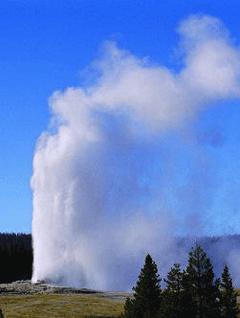
Old Faithful Geyser in Yellowstone National Park (Courtesy of the U.S. Department of Energy)
CURWOOD: Dig down a few feet into the soil here in North America and you’ll find a zone of earth that’s roughly 55 degrees Fahrenheit all the time. It’s a source of heat from the earth that is practically inexhaustible. If you dig down a lot deeper, the earth gets a lot warmer, and in some places you can even find steam, at temperatures of hundreds of degrees. In the next few weeks we’ll report on a major building project that’s tapping so-called geothermal energy just below the surface. But right now we turn our attention to a new study of geothermal resources by the Massachusetts Institute of Technology. It says we could find almost unlimited geothermal energy by digging much deeper into the hot rocks down below, using a new technique called “deep heat mining.” Curt Nickisch of member station WBUR has our report.
NICKISCH: Einstein once said he had little patience for scientists who drill a hole where the drilling’s easy. It was a metaphor of course. But in a basement lab at MIT, Chad Augustine is quite literally drilling a hole where it’s very, very hard: through a slab of granite. And he’s doing so with a pointed blue flame, that’s making the grey stone snap crackle and pop.
It’s uncanny to watch the rock flake under the flame. In about thirty seconds, the torch bores a hole into the rock one inch deep. Augustine wants to repeat this down into the earth, inch by inch, to reach hot water cooking miles below the surface. To do that today with conventional drilling, the cost is in the millions - exponential the deeper you go. Augustine says that’s because drill bits constantly wear out. To replace them, it means bringing up miles of tubing.
AUGUSTINE: So you pull up thirty feet, unscrew it, set it aside. Pull up thirty feet, unscrew it, set it aside. With this though, since the drill it’s just a flame, it never actually comes in contact with the surface, you could theoretically drill forever.
NICKISCH: You wouldn’t need to drill that far. Get about six miles under most of Massachusetts, for instance, and you reach water hot enough to drive a steam turbine to generate electricity.
AUGUSTINE: Like in a place like Boston that doesn’t have a high heat gradient in the Earth, you need a really deep hole to get water at temperatures of 200 or 300 degrees Celsius. Which is really high quality steam – you can use it to make a good geothermal energy plant. And our hope is that with a system like this where you don’t have to stop and take drill pipe out constantly and put it back in, you can get there cheaper and faster.
NICKISCH: And sooner rather than later, hopes MIT chemical engineering professor Jeff Tester. He’s compiled a new report on geothermal energy – the most comprehensive on the resource in decades. It’s a call to arms to invest in this sort of deep heat mining, which is relatively clean. Tester says the payoff could be huge.
TESTER: This is a large resource. Essentially so large that it could be viewed as being sustainable for as long as we’d need it. So it’s not like we’re going to just find a few pockets of hot rock and that will be the end of it in a few years, this could really be viewed as a sustainable resource for the long term.
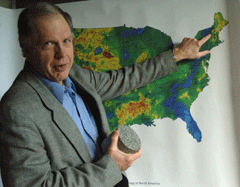
MIT Professor Jefferson W. Tester (Photo: Donna Coveney/MIT)
THORSTEINSSON: So everyone has geothermal district heating, and when I was little I thought that was the only way you could heat houses. And then when I went abroad, I was like: oh, oh no, you don’t have the great resource that we have. So it’s part of just how the country developed, what path you took.
NICKISCH: A new path for the U.S. is mapped out in the MIT study. It calls for up to eight hundred million dollars of investment and research into deep heat mining over the next ten years. That’s when it projects the industry would become competitive on the market - and that fifty years from now, the U-S would get a tenth of its energy from geothermal.
But getting funding from Congress is a hard sell, says Curt Robinson. He runs the non-profit Geothermal Resources Council. He says part of the problem is that America’s geothermal energy plants – mainly in the West - are out of sight, out of mind.

Old Faithful Geyser in Yellowstone National Park (Courtesy of the U.S. Department of Energy)
ROBINSON: It’s largely an invisible form of energy. If there are wind turbines out, one sees the blades spinning and they think: okay, that’s creating power. If one sees solar panels, they see that and think conceivably one’s drawing energy from the sun. Geothermal activity has largely been very regional and very rural.
NICKISCH: That’s mainly because the industry set up plants with the best access to geothermal resources. Jeff Tester at MIT hopes rising demand for renewable energy brings deep heat mining front and center.
TESTER: The opportunity is real. America is particularly well-blessed with geothermal. This would be an enormous asset to our long-term energy security, and I think in a very sustainable fashion.
NICKISCH: Whether more parts of the country are home to geothermal energy plants mining heat miles below the earth’s surface, may depend on whether Tester and others like him can drill their point into the minds of policymakers.
For Living on Earth, I’m Curt Nickisch.
Related links:
- MIT Energy Research Council: "Underground Heat: an omnipresent source of electricity
- The MIT report on "The Future of Geothermal Energy" can be found at the Idaho National Laboratory website on Geothermal Energy
CURWOOD: Coming up, the carbon neutral partner of clean energy is conservation and efficiency and there’s a green building boom sweeping the nation. Even “This Old House” is going greener, and we’ll pay em’ a visit.
[MUSIC Peter Gabriel “Digging In The Dirt” from ‘Us’ (UMG Recordings – 1992)]
Limiting Federal Regulators
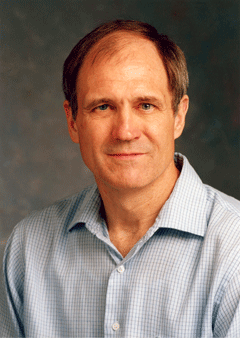
Tom McGarity is a Professor of Law at University of Texas, Austin and the President for the Center for Progressive Reform. (Courtesy of the University of Texas, Austin School of Law)
CURWOOD: President Bush recently amended an executive order that limits the ability of federal agencies, such as the EPA, to create and implement regulations. The changes come as the Bush Administration faces increasing opposition to many of its policies from a Democratic Congress. Joining us to talk about the significance of these new restrictions is Tom McGarity. He’s a Professor of Law at the University of Texas, Austin and the President of the Center for Progressive Reform. Hello Professor McGarity.
McGARITY: Hello.
CURWOOD: Please characterize the President’s new executive order for us. What is it and what does it hope to accomplish?
McGARITY: Well, it’s really an amendment to an existing executive order that’s been around since the Clinton Administration and in fact has had predecessors that go back all the way to the Nixon Administration. Ah. the amendments are rather significant, however, in that they broaden the scope of the view of the White House really, through the Office of Management and Budget , over what the regulatory agencies and the, ah, federal bureaucracy can do by way of imposing new regulations on regulated industries.

Tom McGarity is a Professor of Law at University of Texas, Austin and the President for the Center for Progressive Reform. (Courtesy of the University of Texas, Austin School of Law)
CURWOOD: Yeah, if you could walk me through some of these new restrictions. For example let me ask you about the language in the new rule that states that when agencies plan on issuing a new regulation they have to prove that it addresses a specific quote “market failure.”
McGARITY: This is putting the burden on an agency before it can protect or issue a regulation that would protect human beings, or the environment, to identify as you say some failure of the market. Now a market failure is a situation in which the free market functions poorly. That is, for some reason their prices of a product don’t reflect all of the costs that the manufacturer impose. So this really begins from an assumption or a presumption that the market works well, and that government intervention is only justified in those, sort of, rare occasions when the market somehow fails us.
CURWOOD: What agencies would be most affected by this new rule? Can you give me an example?
McGARITY: Sure I mean, the Environmental Protection Agency first of all is probably the primary target of this rule. I would say that the Occupational Safety and Health Administration is a target of this rule too; could be the National Highway Traffic Safety Administration and the Department of Transportation which regulates cars and, ah, fuel economy standards. That may be what they’re trying to be sure that the agencies toe the line with the White House on things like fuel economy and auto safety.
CURWOOD: So what is the overall aim of this executive order?
McGARITY: Well it clearly represents an attempt by a president whose party has just lost Congress, ah, to assert control over the bureaucracy. And it requires rule-making initiative to get a sign off from a regulatory policy officer who is, I take it, kind of the OMB’s person in the agencies now. So it’s an effort by the White House to reach fairly deeply into the regulatory process and this is very unusual. Um, and of course the burden on the agency to identify market failure is going to mean that they’re going to be less likely to promulgate regulations in the future.
CURWOOD: Looking over, ah, the concerns that the Bush Administration has about bureaucracy what points of agreement do you have with them? Where does this executive order actually help relieve a bloated regulatory process in your mind?
McGARITY: Well, certainly management of a bureaucracy is important. Certainly bureaucracies need to be held politically accountable. And the entity to hold bureaucracies politically accountable is the White House. On the other hand to talk about a bloated bureaucracy putting a lot of, ah, constraints on the business community is simply talk of a generation ago. It’s the sort of thing that may have had some traction and credence during the Carter Administration when the environmental laws were first being enacted and EPA was out there very vigorously going about, perhaps over-vigorously, going about its business, and certainly OSHA was doing the same thing. Um, the argument simply doesn’t hold these days. The Occupational Safety and Health Administration has not issued a single significant regulation in the last six years. So it really doesn’t need constraining.
CURWOOD: Now somebody listening to our conversation might be thinking you know this is all pretty technical stuff, regulations, agencies bureaucracies. They’re going to need another cup of coffee to stay awake. How does this affect the average person on the street in America?
McGARITY: Regulation affects everything that we do. It affects virtually every aspect of our lives; from the food we eat, to the air we breathe, to the water we drink, to the vacation ah, that we’re planning in the woods, or on the ski slopes, to ultimately the national security. And the fact is that, ah, administrative agencies really matter. And if they weren’t there you’d know it really quickly because this market place is quite prone to failure. And people will be harmed. The food they eat will not be safe. The water they drink will have toxins in it. So I think that, as boring as it may be, it is absolutely a vital interest to everyone out there.
CURWOOD: Tom McGarity is professor of law at the University of Texas Austin also president of the Center for Progressive Reform. Thank you so much for taking this time sir.
McGARITY: Well, thank you for having me.
Related links:
- Link to amendments of Exectuive Order 12866
- Center for Progressive Reform
- Office of Management and Budget Watch Dog group
[MUSIC: Ian Boddy “Stormfront” from ‘Elemental’ (DIN – 2006)]
CURWOOD: You can hear our program anytime on our website, or get a download for your Ipod, the address is Living on Earth dot org. That’s Living on Earth dot o-r-g. You can reach us at comments at l-o-e dot org, once again comments at l-o-e dot org. Our postal address is 20 Holland Street, Somerville, Massachusetts, 02144. And you can call our listener line at 800-218-9-9-8-8. That’s 800-218-99-88. CD’s and transcripts are 15 dollars.
Just ahead part Boy Scout and part Sherlock Holmes, Buck Wilder tries to get kids out from in front of their video screens and into the woods. Keep listening to Living on Earth.
ANNOUNCER: Support for the Environmental Health Desk at Living on Earth comes from the Cedar Tree Foundation. Support also comes from the Richard and Rhoda Goldman Fund for coverage of population and the environment and from you, our listeners and from member stations. This is Living on Earth on PRI- Public Radio International.
[MUSIC: Espers “Mansfield And Cyclops” from ‘Espers II’ (Drag City - 2006)]
This Old (Green) House
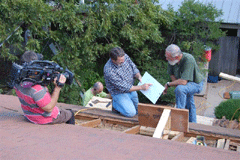
Norm Abrams (left) and Bill Moore (right) working behind the camera. (Photo: Joey Shebesta)
CURWOOD: It’s Living on Earth. I’m Steve Curwood
[THIS OLD HOUSE THEME: Peter Bell “This Old House Theme Music” from ‘This Old House’ (Production Trax – 2006)]
CURWOOD: “This Old House” has been a staple of American public television for more than 20 years. The program nearly invented the now popular genre of do-it-yourself home improvement shows. And the show just hit the big 5-0, its 50th project. For the first time, its hosts are remaking a house entirely in green. It’s a 1926 bungalow in Austin, Texas.
And when it’s done, it’ll be a showcase in sustainable building and energy conservation technologies. Norm Abram is the master carpenter on “This Old House” and Bill Moore has been doing green construction in the Austin area for 20 years. They join us now from the building site in Austin. Norm just exactly where are you guys now?
ABRAM: We’re standing right out in front of the house. Fortunately it stopped raining so we’re not getting drenched today.
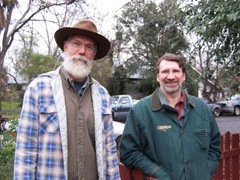
Bill Moore (left) and (right) Norm Abram (Photo: Deborah Hood)
ABRAM: Well, just yesterday in fact, they put in a water collection tank. And what they will be doing is collecting water at the gutters. The rainwater will be collected in the gutters, at the eves of the house, and go to a tank that holds about 1200 gallons of water and that will be able to be stored and used for irrigation purposes.
CURWOOD: Bill, tell me um, what else is green on the building site there? You have rainwater management. What about the lawn?
MOORE: Well, there’s not going to be very much lawn. It’s also going to have a lot of natural or native plants put in so there will be less water needed. That’s one of the things we tried to concentrate on here because we’re always trying to conserve water here.

Norm Abram (left) and Bill Moore (right) working behind the camera. (Photo: Joey Shebesta)
MOORE: Hopefully nothing. Green is not supposed to be something that is unusual. It’s supposed to be, what we’ve been trying to do is make it mainstream. So when you’re looking at the house you just see a nice sort of craftsman bungalow house. That has, the only difference might be is it’s got a nicer metal roof on it.
CURWOOD: Why don’t we take a look inside and see what kind of green magic you’ve done in there.
[CONSTRUCTION SOUNDS]
CURWOOD: The green points for all of this are the bedroom is tiny so that’s saving space and saving consumption.
ABRAM: Exactly.
CURWOOD: And ah…
ABRAM: Very energy efficient windows, reclaimed wood on the floor of the, ah, bedroom. The decking on the deck is a material that’s made out of old plastic bags and wood fiber. So it’s some more material that’s been recycled. And when the kitchen was redesigned, the footprint is no bigger than it was before. The appliances will be more efficient. The cabinets, the new cabinets that are being built, they used MDF, medium density fiber board, for the casings. And used lyptus, which is a very renewable wood that not too many people know about, for the face frames of the cabinets and so forth.
CURWOOD: So, Bill, what makes a house green among other things is energy efficiency. What are the things in this house that make its energy systems especially green?
MOORE: Well, we put in a lot of insulation in the addition and we insulated the lower floor, which hadn’t had any before.
CURWOOD: Now what about a source of energy? You got any wind, solar, geothermal?
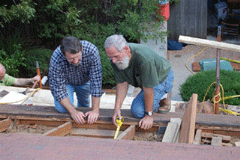
Norm Abram (left) and Bill Moore (right) help a roof go green. (Photo: Joey Shebesta)
MOORE: There is a photovoltaic array on the roof that’ll supply probably 20 percent of the electrical use of the house during the year.
CURWOOD: Why so modest?
MOORE: We actually only had that much roof available that was facing the proper direction and then they just covered that amount.
CURWOOD: At the end of the day what’s it going to cost energy wise compared to what it was running before?
MOORE: What they’re hoping is, the house was increased in size from about 1500 to 2400 or 2300 something like, and but the energy use will probably go down about 40 percent.
CURWOOD: That’s a pretty good deal.
MOORE: Yeah.
CURWOOD: What about the resale side? I know these people, of course, they expect to live there forever. But if they were to sell what kind of financial advantage or disadvantage does greening a house provide when it comes to resale time?
MOORE: Well, uh greening a house a lot of that is just simply building it better. So here if you had a nice house and the price wasn’t outrageous and it was very well built then it would tend to sell much faster. You might not get all of your money back immediately but it would easily sell much faster than anything of comparable size in the area. And if you lived in it long enough you would recoup a lot of your investment because of the savings of energy and water and uh since it’s built better you’d have less maintenance also.
CURWOOD: Norm Abram I’ve got a question for you. “This Old House” has aired for 28 seasons now why go green? Or another way to put it: what took you guys so long?
ABRAM: Well, actually Steve you know we’ve been green for quite some time. Ah, I think “This Old House”, if you look at us historically, there’s a lot of things that we’ve been doing that make us green. We’ve been very conscious of energy efficiency and good insulation, good windows, um, you know using good materials. We recycle materials on our older historic houses and so forth. So, we’ve been green to some level. The reason we came to Austin was because, you know they’ve been working on the idea of green for about 40 years now. And you know, we wanted to go to the place where we felt it was strong and it began and we could get some good lessons. And some of the information that we have here will not only benefit our viewers but it’s going to help us. And when we go back to New England, um, we’re learning something new as well. And we’ll try to be more green in our building
CURWOOD: Norm Abram is the master carpenter on “This Old House” and Bill Moore has been doing green construction in Austin for about 20 years. On February 8th This Old House will broadcast the first of eight episodes on their renovation project there in Austin. Gentlemen thank you both for being on the show.
MOORE: Thank you Steve.
ABRAM: Thank you.
Related link:
"This Old House" website
[MUSIC: Peter Bell “This Old House Theme Music” from ‘This Old House’ (ProductionTrax – 2006)]
CURWOOD: And you can find a link to This old House and other green building resources on our web site, loe.org. And we’d love to hear what you think about our program. You can reach us at comments @ l-o-e dot O-R-G. That’s comments @ l-o-e dot org. Our listener line is 800-218-9988. That's 800-218-99-88. And our postal address is 20 Holland Street, Somerville, Massachusetts, 02144. You can hear our program or get a download anytime on our website, LOE dot O-R-G That's LOE dot org.
Just ahead, grab your kids, gather ‘round your portable radio and head for the woods it’s time for the adventures of Buck Wilder. First this Note on Emerging Science from Meghan Vigeant.
Emerging Science Note/Pills or Placebos?

Real? Fake? It may be hard to know. (Courtesy of the VA Healthcare Network)
[SCIENCE NOTE THEME]
VIGEANT: Feel a headache coming on? So you go to the bathroom, open the medicine cabinet and reach for the ibuprofen. But what if that pill doesn’t help the pain? What if it was a fake, or worse; contaminated? Counterfeit drugs are a serious problem, especially in parts of the developing world. Even the FDA has encountered problems with counterfeits here in the US. They’re packaged just like the real thing. So how would you know your pill is a fake?

Real? Fake? It may be hard to know. (Courtesy of the VA Healthcare Network)
Well now there’s a way to see past the packaging to know if the drug is real or bogus. British scientists, Pavel Matousek and Charlotte Eliasson have developed a drug detector. They’ve applied a technique called Raman Spectroscopy, which is used to identify chemical compounds by examining the light they reflect. After some trial and error the scientists found the best angle to direct a laser at the container of drugs. Once the laser hits the pills inside, chemicals in the drug emit infrared radiation. If the drug is the real thing it will emit a specific pattern of light, like a fingerprint. If the prints don’t match, you know it’s a con.
But don’t expect to see a hand held drug detector in every cabinet or even every pharmacy soon. The detector device cost around 20 to 40 thousand U.S. dollars. So, for the time being, if that headache is still bothering you, you might want to just drink a cup of hot tea, relax and enjoy the rest of the show. That’s this week’s note on emerging science, I’m Meghan Vigeant.
Life Lessons From Wildlife

Buck Wilder and his various titles. (Courtesy of Mackinac Island Press)
CURWOOD: Buck Wilder is part Boy Scout, part Sherlock Holmes, and part Mr. Rogers. You’ll find him deep in the forest, gathered with his animal friends on the trail of some kind of mystery. And at the end of the mystery, there’s usually some sort of lesson about nature and the outdoors. Buck Wilder is the creation and sometimes the alter ego of author Tim Smith. In the last few months Tim Smith has released not one but three new Buck Wilder books for grade-schoolers. The series begins with Buck Wilder’s Adventures #1: “Who Stole the Animal Poop?” Tim Smith recently came in from the woods to talk about the book with Living on Earth’s Bruce Gellerman.
SMITH: It’s the first book in a series of out door stories. They are stories for kids that are in elementary school, the beginning years of elementary school. And they’re stories about dilemmas and problems that happen in the woods. And Buck Wilder lives in the woods and he’s very friendly and he knows all the animals. And his animal friends come to Buck to help solve the problems in the woods.
They’re stories about the outdoors and what you can learn from the outdoors and the value of the outdoors and how we’re all connected in it. I try to make the titles and the subjects fun like, “The Time the Squirrels Went Nuts” “When Time the Owls Didn’t Give a Hoot Anymore” “The Time the Salmon Stopped Running” “When the Ants Dug to China” “When the Work Bees Go on Strike.” And you know those are all the titles of the stories.

Buck Wilder and his various titles. (Courtesy of Mackinac Island Press)
SMITH: The dilemma is one of the animals comes to Buck Wilder and says, “Hey someone is in the woods and stealing all the animal poop. They’re sweeping it up. And why would somebody do such a stinky thing? Why would somebody do that?” and Buck goes, “I don’t know. Let’s go out and see if we can figure it out.” And actually the poop that’s left, and I call it that, the animal droppings in the woods are part of animal’s trails and they know, who’s been around, who’s been coming, and in the woods it’s a natural part of the woods: the decaying process, the fertilizing process and that’s kind of the environmental part of it. And so the dilemma is animals can’t find their, their tracks are being swept up also. They don’t know who’s come to visit. They’re loosing their trails. They’re loosing their scent. And Buck has to help solve that problem. That’s the dilemma in the woods.
GELLERMAN: Well, you’ve got some great characters in the book. Rascal the Raccoon, Wendell Wabbit, am I pronouncing that correct?
SMITH: That’s correct.
GELLERMAN: Sly Fox.
SMITH: Mmm Hmm
GELLERMAN: You find them in your back yard?
SMITH: I find them in my back yard. That’s right. All those characters, what I try to do is write stories that are fun about outdoors so it really gets kids and families thinking about going out and taking a look at it. The stars are always out there. It’s up to us to go out and look at ‘em. Get your imagination going, you start thinking about other things in life. Take you back to your childhood a little bit. I’ve done a lot of work for the DNR, Department of Natural Resources, in some states around the country and I may not be exact with this number but it’s staggering. I’m going to be really close. It’s been found today that the average American spends less than ten minutes a day outside. They’re not appreciating and knowing what, what’s out there and how we’re all connected to it.
And I believe truly that we can learn so much from the animals. Every single animal has an attribute or something about it that applies to our life. If you pay attention to, I don’t care what it is. You hear stories about the geese, insects or the bees, they’re fascinating. Ants alright, if you watch ants they’ll run along a trail. What they do, ants actually put a scent down called pheromone and they leave a trail for the next ant and the next ant follows that trail. When I was a kid I used to sit there and I’d wet my finger and I’d run it across that trail, just run it in the dirt. And the ant would come right to that line I drew in the dirt and he’d stop. And he can’t get beyond it because the trail’s broken. You watch them. It’s like a backup on the expressway. They all start bumping into each other. And they’ll back up, there will be a whole bunch of them. And they run back and forth and they don’t know where to go and finally they’ll find their way around. This was my way of tormenting ants when I was a kid.
But they actually talk to each other with their antennas. They pop their antennas together and they say things like, “Hey somebody just dropped a peanut butter and jelly sandwich in the parking lot. Come on let’s go!” or “Hey, there’s Chinese food over there by the dumpster! Come on!” And off they go, you know. Ants actually turn more soil, they till more soil than anything on the earth. They aerate our soil. They aerate the roots and in that turning of the soil they turn over and they plant seeds and so forth. Actually the combined weight of ants on this earth is greater than the combined weight of humans on this earth.
GELLERMAN: Buck Wilder sounds really like a lot of fun and a really happy guy. But when I hear you I hear a little sadness.
SMITH: Um, really? Well, there is some sadness in there and it’s very observant that you pick that out. My sadness in there is that um.... hunting licenses, fishing licenses, so forth, are down across the country. People aren’t going out hunting or fishing or camping or hiking like they were 20, 30, 40 years ago. The sadness if anything is that you can not sit down with a computer game in your house and give it to your kids and have them simulate an outside experience. It cannot be done. They do not feel the wind on their face. They don’t pay attention to the clouds that are going over. They don’t hear the birds. Actually, they don’t even pay attention to the trees or when the owls make a call. And we’re part of that. And, you know you go through your life, and Bruce, I don’t know how old you are or if you have children or what ever it is, but if you ever have to find some peace yourself you can walk outside. You can go down and sit by a stream. You can go for a walk in the woods. You can find the peace. What kind of peace are you going to find sitting down and playing a simulating computer game? You’re not going to go to that. You need to go to the outside for it.
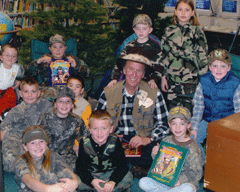
Buck and some of his smallest fans. (Courtesy of Mackinac Island Press)
GELLERMAN: At the end of your book, “Who Stole the Animal Poop?” you have a decoder page in which kids can actually put together a puzzle.
SMITH: Yes.
GELLERMAN: And I’m wondering, um, I remember the decoder rings, Buck Rogers.
SMITH: Yes exactly! I remember Buck, how old are you Bruce?
GELLERMAN: Ohhh, not far behind you.
SMITH: Not far, about the same, ok because you know who Buck Rogers is.
GELLERMAN: I do indeed.
SMITH: As a boy I liked maybe it was Boy’s Life Magazine or something I can’t remember. But I used to like to flip the edge of the page and there was a little flicker animal that went PFFFF and it flies up and down the pages. And I put those in my book so I had fish going up and down and rabbits going. And it’s fun to go through a book and what I did was I put a secret decoder page at the very end of these, because there’s a lot of drawings in the book, a lot of illustrations, and I hide a letter in most of the drawings and then you have to go back and look at the book again, study it, and there’s a secret message, it’s kind of a code and you put the code together and it’s a Buck Wilder message and it’s, there’s more to a book sometimes than just reading the words. I want you to have fun with it.
GELLERMAN: Well, Tim Smith thank you very much. I appreciate it.
SMITH: My pleasure. Thank you very much Bruce.
CURWOOD: Tim Smith is the author of the Buck Wilder series of children’s books.
He spoke with Living on Earth’s Bruce Gellerman.
Related link:
Buck Wilder Adventures and Books
[MUSIC: Perry & Kingsley “Swan’s Splashdown” from ‘Incredibly Strange Music (Volume 1)’ (Caroline – 1993)]
CURWOOD: Next week on Living on Earth, Borneo is a hotbed of biological diversity. It’s also a hotspot of development…
TOMASEK: And I thought, you know, there are few places in the world where you can actually sit and take in such a visually stimulating experience where you see so many different types of species that you can only see on this one given island.
CURWOOD: The spotlight is on the struggle to save the Borneo rainforest and the incredible array of animals and plants that live in it.
CURWOOD: We leave you this week in Buck Wilder’s neck of the woods or neck of the lake in the state of Michigan.
[EARTH EAR: “Lake Superior, Michigan” recorded by Neal Ewers for “Sound Tapestry Nature Collection” (Ravenswood Productions – 2003)]
Around Michigan’s Upper Peninsula, the landscape is a subtle composition of fields, streams, forests and the waters of three of the Great lakes Michigan, Huron and Superior.
Neal Ewers made this recording along the shores of Lake Superior, the greatest of the Great Lakes.
Living on Earth is produced by the World Media Foundation. Our crew includes Ashley Ahearn, Eileen Bolinsky, Bruce Gellerman, Ian Gray, Ingrid Lobet, Jennifer Percy, Emily Taylor, Peter Thomson and Jeff Young - with help from Bobby Bascomb and Kelley Cronin. Our interns are Paige Doughty and Meghan Vigeant. Dennis Foley is our technical director. Alison Lirish Dean composed our themes. You can find us at loe dot org. I’m Steve Curwood Thanks for listening.
ANNOUNCER: Funding for Living on Earth comes from the National Science Foundation, supporting coverage of emerging science; and Stonyfield Farm organic yogurt, smoothies and milk. Ten percent of profits are donated to efforts that help protect and restore the earth. Details at Stonyfield dot com.
Support also comes from you our listeners, the Ford Foundation, the Educational Foundation of America and the Saunders Hotel Group of Boston's Lennox and Copley Square Hotels. Serving you and the environment while helping preserve the past and protect the future, 800-225-7676.
Living on Earth wants to hear from you!
Living on Earth
62 Calef Highway, Suite 212
Lee, NH 03861
Telephone: 617-287-4121
E-mail: comments@loe.org
Newsletter [Click here]
Donate to Living on Earth!
Living on Earth is an independent media program and relies entirely on contributions from listeners and institutions supporting public service. Please donate now to preserve an independent environmental voice.
Newsletter
Living on Earth offers a weekly delivery of the show's rundown to your mailbox. Sign up for our newsletter today!
 Sailors For The Sea: Be the change you want to sea.
Sailors For The Sea: Be the change you want to sea.
 The Grantham Foundation for the Protection of the Environment: Committed to protecting and improving the health of the global environment.
The Grantham Foundation for the Protection of the Environment: Committed to protecting and improving the health of the global environment.
 Contribute to Living on Earth and receive, as our gift to you, an archival print of one of Mark Seth Lender's extraordinary wildlife photographs. Follow the link to see Mark's current collection of photographs.
Contribute to Living on Earth and receive, as our gift to you, an archival print of one of Mark Seth Lender's extraordinary wildlife photographs. Follow the link to see Mark's current collection of photographs.
 Buy a signed copy of Mark Seth Lender's book Smeagull the Seagull & support Living on Earth
Buy a signed copy of Mark Seth Lender's book Smeagull the Seagull & support Living on Earth

